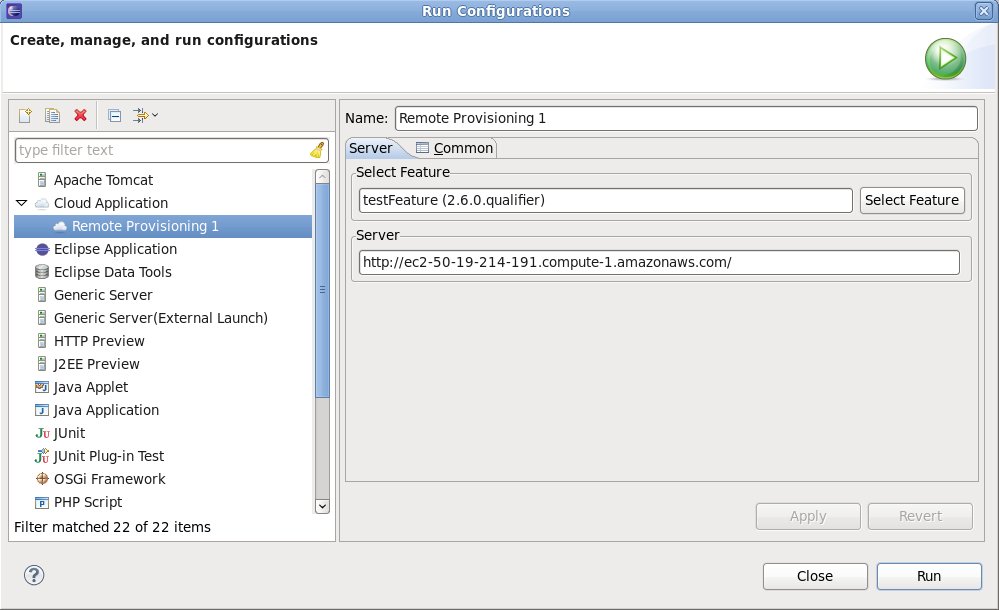Notice: this Wiki will be going read only early in 2024 and edits will no longer be possible. Please see: https://gitlab.eclipse.org/eclipsefdn/helpdesk/-/wikis/Wiki-shutdown-plan for the plan.
Difference between revisions of "HttpDeployer"
(initial) |
|||
| (4 intermediate revisions by the same user not shown) | |||
| Line 10: | Line 10: | ||
== Introduction == | == Introduction == | ||
| + | |||
| + | The core idea of the HTTP Deployer is to provide a Run Configuration that allows for Remote Provisioning of any Eclipse Feature to a Eclipse RTP based runtime. You can find the complete project proposal and description at [http://wiki.eclipse.org/HttpDeployer_Proposal Proposal]. The image below shows the new Run Configuration. It's also an Screencast available that demonstrates the current state of the HttpDeployer, see [http://vimeo.com/27927789 http://vimeo.com/27927789] | ||
| + | |||
| + | [[Image:HTTPDeployer-Run-Configuration.jpg]] | ||
| + | |||
| + | == Howto == | ||
| + | |||
| + | At this time it's required to install a Web Service on the target environment that allows to control the runtime remotely. This step might be obsolete in the future, as we plan to include this service in Eclipse RTP packages. Furthermore it's required to install the UI-Plugins in the Eclipse IDE. | ||
| + | |||
| + | A detailed documentation of the installation procedure can be found at [http://wiki.eclipse.org/HttpDeployer_HowTo HttpDeployer_HowTo]. | ||
== API == | == API == | ||
| + | |||
| + | The HTTP Deployer provides an API that allows to control Eclipse RTP based OSGi Runtimes remotely. This API is currently used by the HTTP Deployer UI Code for the Remote Provisioning operations. It might, however, also be used by third-party applications and is documented at [http://wiki.eclipse.org/HttpDeployer_API HttpDeployer_API]. | ||
Latest revision as of 10:22, 26 October 2011
Contents
HTTP Deployer
Project Description: Eclipse developers use JDT to build awesome Java applications. They use Mylyn to focus their work. They use PDE to domesticate the power of EclipseRT. And they use command line tools to deploy their bundles and features. This project is proposed to implement tooling that allows for one-click deployment of any existing Eclipse Feature, for example Eclipse Orion, to Amazon’s EC2.
This project as submitted to the Eclipse Foundation has been accepted for Google Summer of Code 2011.
Student: Sebastian Schmidt
Mentor: Holger Staudacher
Introduction
The core idea of the HTTP Deployer is to provide a Run Configuration that allows for Remote Provisioning of any Eclipse Feature to a Eclipse RTP based runtime. You can find the complete project proposal and description at Proposal. The image below shows the new Run Configuration. It's also an Screencast available that demonstrates the current state of the HttpDeployer, see http://vimeo.com/27927789
Howto
At this time it's required to install a Web Service on the target environment that allows to control the runtime remotely. This step might be obsolete in the future, as we plan to include this service in Eclipse RTP packages. Furthermore it's required to install the UI-Plugins in the Eclipse IDE.
A detailed documentation of the installation procedure can be found at HttpDeployer_HowTo.
API
The HTTP Deployer provides an API that allows to control Eclipse RTP based OSGi Runtimes remotely. This API is currently used by the HTTP Deployer UI Code for the Remote Provisioning operations. It might, however, also be used by third-party applications and is documented at HttpDeployer_API.

